
Sir Terence David John Pratchett was an English author, humorist, and satirist, best known for his 41 comic fantasy novels set on the Discworld, and for the apocalyptic comedy novel Good Omens (1990) which he wrote with Neil Gaiman.
The technological singularity—or simply the singularity—is a hypothetical future point in time at which technological growth becomes uncontrollable and irreversible, resulting in unforeseeable consequences for human civilization. According to the most popular version of the singularity hypothesis, I. J. Good's intelligence explosion model, an upgradable intelligent agent will eventually enter a positive feedback loop of self-improvement cycles, each new and more intelligent generation appearing more and more rapidly, causing a rapid increase ("explosion") in intelligence which ultimately results in a powerful superintelligence that qualitatively far surpasses all human intelligence.
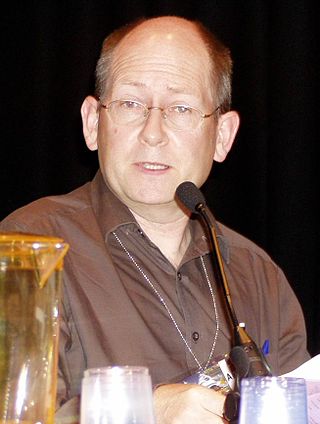
Stephen Baxter is an English hard science fiction author. He has degrees in mathematics and engineering.

The Berserker series is a series of space opera science fiction short stories and novels by Fred Saberhagen, in which robotic self-replicating machines strive to destroy all life.

Strata is a 1981 science fiction comedy novel by Terry Pratchett. It is one of Pratchett's first novels and one of the few purely science fiction novels he wrote, along with The Dark Side of the Sun.

The Dark Side of the Sun is a science fiction novel by Terry Pratchett, first published in 1976.

The Discworld is the fictional setting for all of Terry Pratchett's Discworld fantasy novels. It consists of a large disc resting on the backs of four huge elephants which are standing on the back of an enormous turtle, named Great A'Tuin as it slowly swims through space. Magic is an everyday feature of life on Discworld, whilst even science has unearthly qualities. The similarities to Planet Earth only exacerbate the strangeness of Discworld itself.
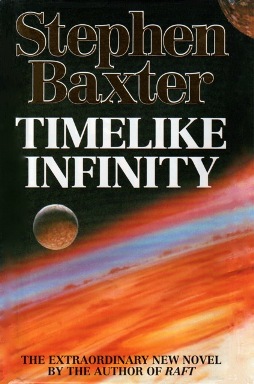
Timelike Infinity is a 1992 science fiction book by British author Stephen Baxter. The second book in the Xeelee Sequence, Timelike Infinity introduces a universe of powerful alien species and technologies that manages to maintain a realistic edge because of Baxter's physics background. It largely sets the stage for the magnum opus of the Xeelee Sequence, Ring.
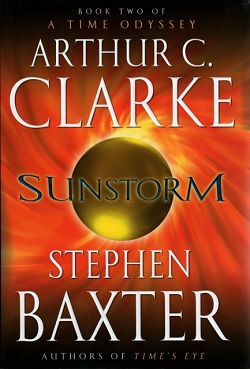
Sunstorm is a 2005 science fiction novel co-written by British writers Arthur C. Clarke and Stephen Baxter. It is the second book in the series A Time Odyssey. The books in this series are often likened to the Space Odyssey series, although the Time Odyssey novels ostensibly deal with time where the Space Odyssey novels dealt with space. The first book in the series was Time's Eye.

A glass knife is a knife with a blade made of glass, with a fracture line forming an extremely sharp cutting edge.

Manifold: Space is a science fiction book by British author Stephen Baxter, first published in the United Kingdom in 2000, then released in the United States in 2001. It is the second book of the Manifold series and examines another possible solution to the Fermi paradox. Although it is in no sense a sequel to the first book it contains a number of the same characters, notably protagonist Reid Malenfant, and similar artefacts. The Manifold series contains four books, Manifold: Time, Manifold: Space, Manifold: Origin, and Phase Space.

When Worlds Collide is a 1951 American science fiction disaster film released by Paramount Pictures. It was produced by George Pal, directed by Rudolph Maté, and stars Richard Derr, Barbara Rush, Peter Hansen, and John Hoyt. The film is based on the 1933 science fiction novel of the same name, co-written by Edwin Balmer and Philip Wylie.
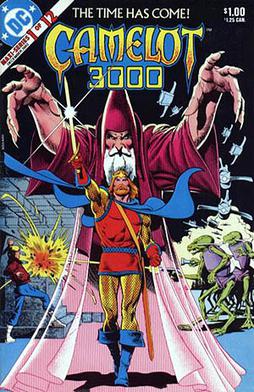
Camelot 3000 is an American twelve-issue comic book limited series written by Mike W. Barr and penciled by Brian Bolland. It was published by DC Comics from 1982 to 1985 as one of its first direct market projects, and as its first maxi-series. It was also the first comic book series to be printed on Baxter paper instead of newsprint.

"The Brick Moon" is a novella by American writer Edward Everett Hale, published serially in the magazine The Atlantic Monthly in 1869. It is a work of speculative fiction containing the first known fictional description of an artificial satellite.

The Long War is a science fiction novel by British writers Terry Pratchett and Stephen Baxter. It is a sequel to their parallel-Earth novel The Long Earth. This book is the second in a five-book series.
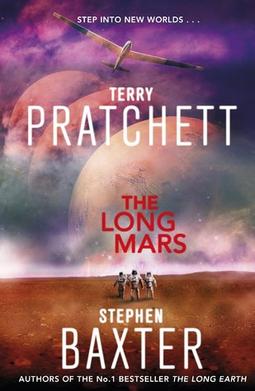
The Long Mars is a science fiction novel by Terry Pratchett and Stephen Baxter.

The Long Utopia is a science fiction novel by Terry Pratchett and Stephen Baxter published on 23 June 2015.
The Long Earth is a collaborative science fiction novel series by British authors Terry Pratchett and Stephen Baxter.

The Long Cosmos is a science fiction novel by Terry Pratchett and Stephen Baxter published on 30 June 2016. It is the final installment in the award-winning five-book parallel-Earth series The Long Earth.
















